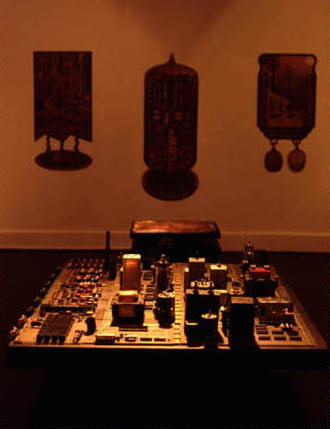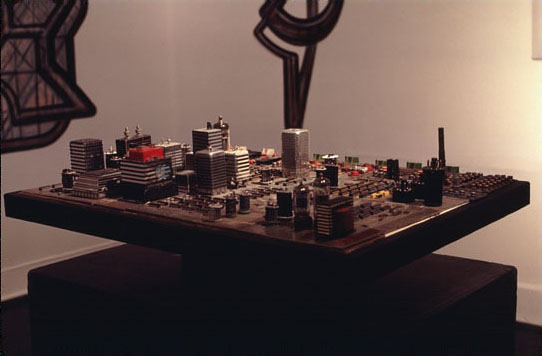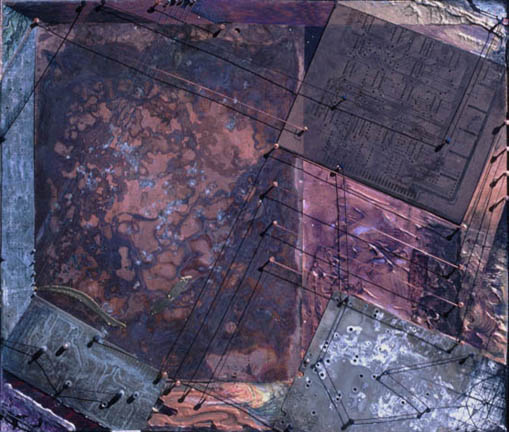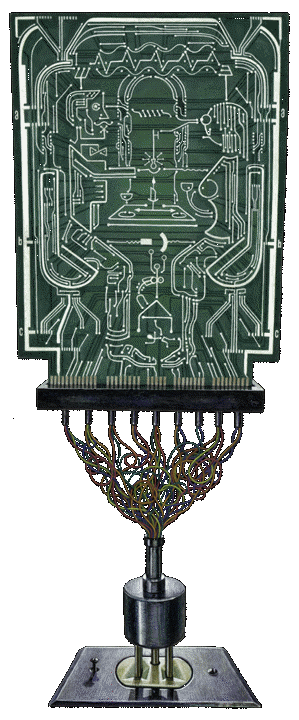
I included a few of the pieces from this exhibition in 1984 to show the origins of my interest in computers and using them as potential subject matter and physical elements in my art. Also I thought it would help clarify the roots of the concepts that inspire my more recent work today. |
This page contains 5 images from this
show. Scroll down to seea selection
of the work.

In this photo you can see partial overview of the gallery space which included about a dozen pieces. The main area of exploration for this show was the interrelationships of forms both natural and manmade. I wanted to say more about the forms I used and depicted than just how they looked. I felt the need to communicate about the inner characteristics that gave forms their appearance and I explored a variety of ways this could be done both in sculpture and painting. Juxtaposition and metamorphosis between seemingly unrelated elements or systems to reveal a deeper connection was one of the techniques I employed. Below you will see examples and explanations which should help clarify the concepts underlying my imagery. |
VACUUM TUBE
This drawing done in charcoal and conte crayon on cutout wood depicts a vacuum tube used in amplifiers and early electronics. I collected parts of old computers and other electronic devices to use in my sculptures and while looking closely at one of these tubes I noticed a little building like part in them and the fountain where the current enters the tube. I wasn't sure what I would use for a plug-in base until I noticed a man hole cover for the Seattle Sewer with its ring of holes that matched the tube plug-in perfectly. |

CIRCUIT CITYSCAPE
At the time of this exhibition (1984), I had never seen or heard of this concept being used in a piece of art of any kind before. This sculpture is made of parts from computers bought at Boeing Surplus in Seattle and put together to create a very convincing cityscape. The similarities I found interesting here are the systems of cities and the systems of circuitry. In both there is the need to move things about using roads, plumbing or circuits and an organization of functions into different areas such as an industrial area vs. a residential area. It is the functional similarities along with the economic use of space that creates the likeness of the forms. Even today as circuits have been reduced in size one can't help but see the similarity in appearance they have with cities when looking at a circuit board in a computer. |

CIRCUITSCAPE
This combination of sculpture and painting echoes the look of aerial views of earth where mankind's imposition of geometry on the natural world creates a veil over the organic forms of the landscape. Composite elements in this piece include photos of clouds on Jupiter, maps of cities blended into corroded circuit boards found in a junk pile, thick paint creating natural forms and satellite photos of the Earth. It was apparent to me that similarity of shapes such as patterns on a corroded piece of copper and the clouds of a planet revealed some similarity in their inner nature. Today with fractal and chaos mathematics these kinds of forms are becoming more understood by scientists. As an artist in 1983 I could only express what I was noticing visually. |

SURVIVAL CIRCUIT
This acrylic painting on cutout paper done in 1983 was a little different approach in
expressing similarities of seemingly unrelated things with a touch of humor. It seems that
much of human behavior is wired into us or programmed above our so called freewill.
Whether it is through evolution and survival or from a God who snapped his fingers human
programs are obvious to anyone who cares to notice them. |